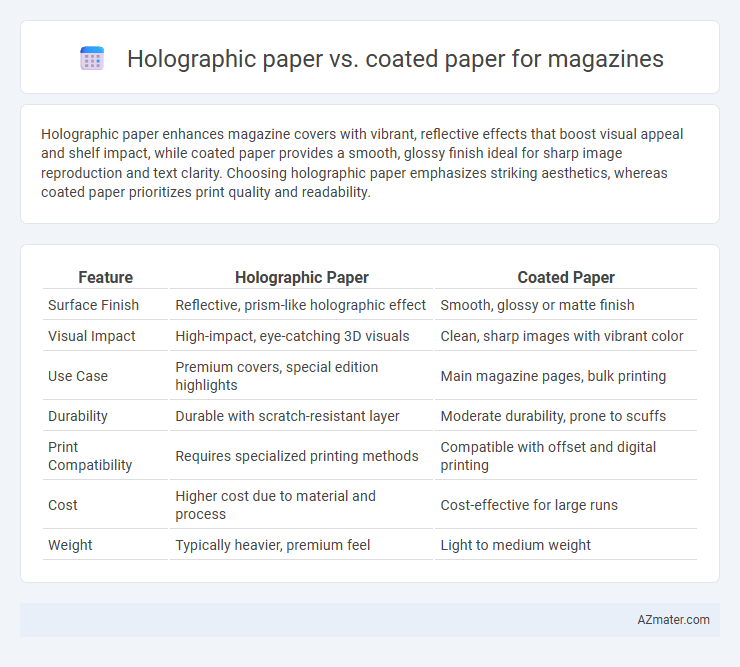Holographic paper enhances magazine covers with vibrant, reflective effects that boost visual appeal and shelf impact, while coated paper provides a smooth, glossy finish ideal for sharp image reproduction and text clarity. Choosing holographic paper emphasizes striking aesthetics, whereas coated paper prioritizes print quality and readability.
Table of Comparison
| Feature | Holographic Paper | Coated Paper |
|---|---|---|
| Surface Finish | Reflective, prism-like holographic effect | Smooth, glossy or matte finish |
| Visual Impact | High-impact, eye-catching 3D visuals | Clean, sharp images with vibrant color |
| Use Case | Premium covers, special edition highlights | Main magazine pages, bulk printing |
| Durability | Durable with scratch-resistant layer | Moderate durability, prone to scuffs |
| Print Compatibility | Requires specialized printing methods | Compatible with offset and digital printing |
| Cost | Higher cost due to material and process | Cost-effective for large runs |
| Weight | Typically heavier, premium feel | Light to medium weight |
Introduction to Magazine Paper Choices
Magazine paper choices significantly impact print quality and reader experience, with holographic paper offering vibrant, eye-catching visuals due to its reflective surface, ideal for premium editions and special features. Coated paper, available in gloss, matte, or satin finishes, provides smooth texture and sharp image reproduction, balancing cost-efficiency and durability. Selecting between holographic and coated paper depends on desired aesthetic appeal, print clarity, and budget considerations for magazine production.
What is Holographic Paper?
Holographic paper is a specialized printing substrate embedded with a multi-dimensional, reflective surface that creates a shimmering, rainbow-like effect, enhancing visual appeal for magazine covers and inserts. Unlike coated paper, which features a smooth, glossy or matte finish tailored for sharp image reproduction and durability, holographic paper emphasizes striking, eye-catching aesthetics through light diffraction. This unique optical property makes holographic paper ideal for premium magazines seeking to attract reader attention and convey a futuristic or luxury brand image.
What is Coated Paper?
Coated paper is a type of paper that has a surface coated with materials like clay or calcium carbonate to enhance gloss, smoothness, and print quality, making it ideal for high-resolution magazine images and vibrant color reproduction. It provides a durable finish that resists ink absorption, ensuring sharp text and graphics essential for professional magazine layouts. Compared to holographic paper, coated paper offers a more traditional, polished look without the reflective or shimmering effects, suitable for standard editorial and advertising content.
Visual Appeal: Holographic vs Coated
Holographic paper offers a striking, dynamic visual appeal with its reflective, prism-like surface that shifts colors and light, creating an eye-catching effect ideal for luxury or entertainment magazines. Coated paper provides a smooth, glossy finish that enhances image clarity and color vibrancy, ensuring crisp and sharp visuals suited for high-quality photo spreads and text readability. While holographic paper captivates with its unique, attention-grabbing aesthetic, coated paper excels in delivering consistent color fidelity and professional polish.
Print Quality and Color Accuracy
Holographic paper enhances magazine print quality by adding a reflective, multidimensional effect that makes colors appear more vibrant and dynamic, improving visual impact. Coated paper provides a smooth, glossy surface that ensures consistent color accuracy and sharp details, making it ideal for high-resolution images and intricate designs. While holographic paper emphasizes eye-catching aesthetics, coated paper offers superior color fidelity and precise print reproduction for professional magazine layouts.
Durability and Handling
Holographic paper offers superior durability due to its protective laminate layer, making it resistant to scratches, moisture, and fading, which enhances the magazine's lifespan. Coated paper, while smooth and ideal for vibrant color reproduction, is more prone to creasing, scuffing, and moisture damage, affecting its handling quality over time. For magazines requiring extended durability and premium tactile experience, holographic paper is a more resilient choice compared to standard coated paper.
Environmental Impact Comparison
Holographic paper for magazines typically involves plastic-based coatings, leading to challenges in recycling and longer decomposition times compared to coated paper, which is often cellulose-based and more environmentally friendly. Coated paper can be recycled more efficiently and generates less pollution during processing, contributing to reduced environmental impact. The use of holographic paper raises concerns about microplastic contamination and energy-intensive production, making coated paper a preferable choice for eco-conscious publishing.
Cost Analysis: Holographic vs Coated
Holographic paper typically costs 30-50% more than coated paper due to specialized materials and production processes required for its reflective, multi-dimensional finish. Coated paper remains a budget-friendly choice with consistent pricing, making it ideal for mass-market magazines focused on cost-efficiency. Cost analysis shows that while holographic paper enhances visual appeal and attracts premium advertisers, coated paper provides reliable print quality at a significantly lower expense for large print runs.
Best Uses for Each Paper Type
Holographic paper is best used for magazine covers and special edition pages where eye-catching, reflective effects enhance visual appeal and attract reader attention. Coated paper, typically gloss or matte, is ideal for high-quality image reproduction and smooth text presentation within magazine interiors, providing vibrant colors and sharp details. Choosing holographic paper elevates brand prestige through striking finishes, while coated paper ensures consistent print quality and readability for extensive editorial content.
Choosing the Right Paper for Your Magazine
Choosing between holographic paper and coated paper for your magazine depends on your desired visual impact and content type. Holographic paper enhances visual appeal with reflective, prismatic effects ideal for special editions or eye-catching covers, while coated paper offers a smooth, glossy or matte finish that improves image clarity and color vibrancy for text-heavy or photographic layouts. Prioritize coated paper for everyday readability and cost-effectiveness, and select holographic paper when aiming to create a standout, premium look that attracts readers' attention on newsstands.

Infographic: Holographic paper vs Coated paper for Magazine
 azmater.com
azmater.com